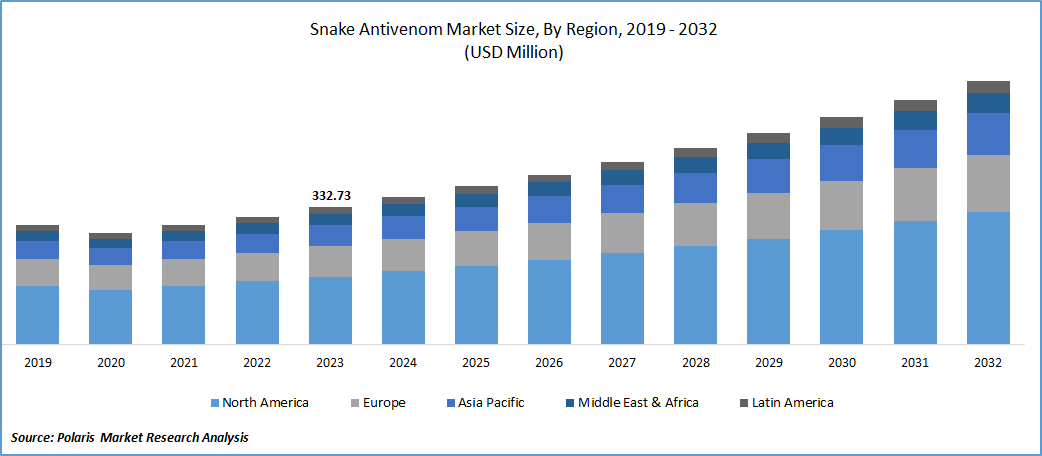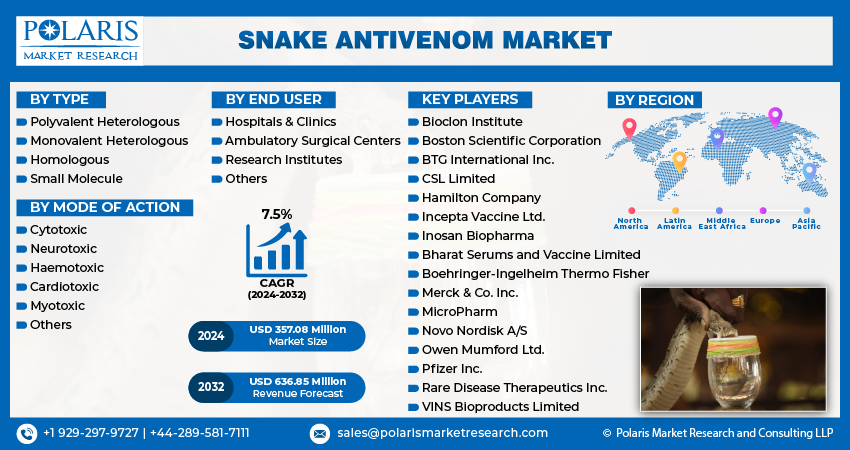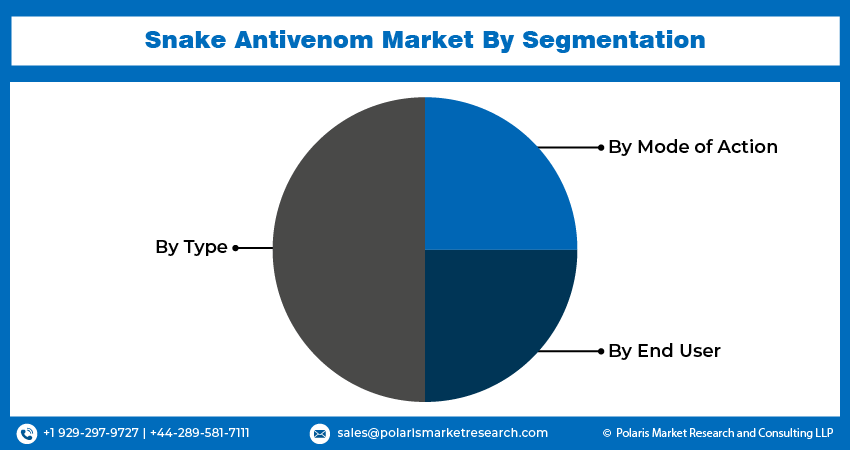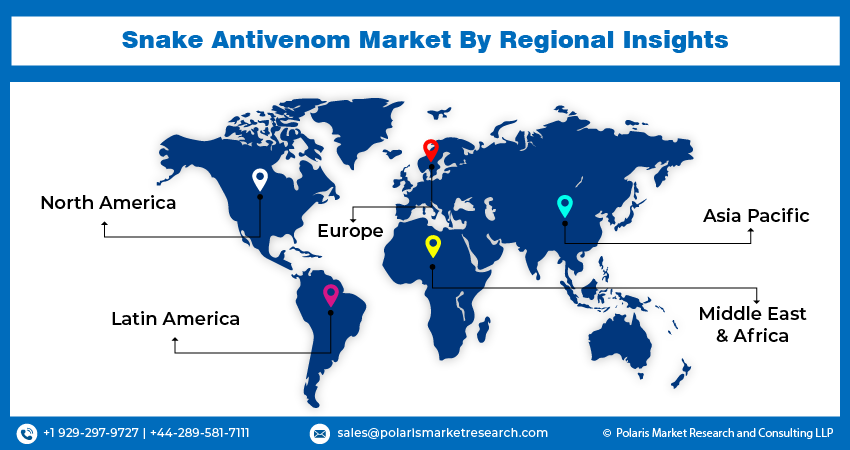
Snake Antivenom Market Share, Size, Trends, Industry Analysis Report, By Type (Polyvalent Heterologous, Monovalent Heterologous, Homologous, and Small Molecule Anti-Toxins); By Mode of Action; By End User; By Region; Segment Forecast, 2024 – 2032
- Published Date:Mar-2024
- Pages: 119
- Format: PDF
- Report ID: PM4444
- Base Year: 2023
- Historical Data: 2019-2022
Report Outlook
The global snake antivenom market was valued at USD 332.73 million in 2023 and is expected to grow at a CAGR of 7.5% during the forecast period.
The drastic increase in the number of snake bites worldwide and growing incidences of deaths every year because of venomous bites, are the leading factors boosting market’s growth. Also, the growing people awareness regarding the available treatment options for snakebite and focus of government and non-government organizations globally towards reducing the number of mortality due to snakebites, are further influencing the global market growth.

To Understand More About this Research:Request a Free Sample Report
- For instance, according to a report published by the World Health Organization, more than 5.4 Mn people are bitten by the snakes each year with almost 1.8-2.7 Mn cases of envenoming’s. And, 81,410 to 137,880 people globally die each year due to snake bites and around 3 times as many amputations or other disabilities are caused by such bites.
Furthermore, the growing technological advancements and surge in the number of favorable initiatives by various leading international health organizations for promoting awareness about the availability of effective antivenoms, resulting in greater demand for effective antivenoms. Thereby, key players are focusing on the creation of safe and more effective antivenoms such as polyvalent antivenoms with ability to neutralize venoms from different species including snakes.
However, the increasing costs of anti-venoms over last two decades which makes it difficult to access for most people coupled with the lack of awareness among people in low-and-middle income countries about the availability and potential of antivenoms, are key factors restraining the market’s growth.
Industry Dynamics
Growth Drivers
- Growing incidences of snakebites and rising investments on R&D activities spurring the global market growth
The exponential increase in the incidences of snakebites especially in tropical and sub-tropical regions and its emergence as a common public health issue causing various types of complications like tissue damage, paralysis, fatal hemorrhage, limb amputation, and many others, are leading factors boosting the market’s growth.
- For instance, according to WHO, it is estimated that more than 1,2 million people have died from snake bites in India over the last 20 years, with majority of people were aged between 30 and 69 years old.
In addition, there has been a significant increase in number of snakebites globally that forced government and private organizations to implement on research & development efforts to mitigate the effect on snakebites and develop new antivenoms with enhanced characteristics, which in turn, likely to drive market’s growth.

Report Segmentation
The market is primarily segmented based on type, mode of action, end user, and region.
|
By Type |
By Mode of Action |
By End User |
By Region |
|
|
|
|
To Understand the Scope of this Report:Speak to Analyst
By Type Analysis
- Polyvalent heterologous segment accounted for the largest market share in 2023
The polyvalent heterologous segment accounted for the largest market share. Segment’s dominance is attributable to its widespread adoption and preference over monovalent antivenom due to its ability to provide higher effectiveness and safety and easy accessibility in healthcare facilities like hospitals and clinics.
The monovalent heterologous segment is projected to exhibit highest growth rate. This is due to wide range of advantages such as enhanced penetration into tissue, better efficiency, high affinity for venom antigen, and minimal side effects compared to others.
By Mode of Action Analysis
- Neurotoxic segment held the majority market share in 2023
The neurotoxic segment held the majority market share. Segment’s dominance is driven by substantial increase in the prevalence of neurotoxic snakebites in some specific region and constant growth in the focus and penetration among healthcare organizations for research & development that lead to creation of new neurotoxic antivenom with improved neutralizing capabilities and reduced side effects.
The cytotoxic segment is projected to register significant growth rate. This growth is attributed to its greater effectiveness and specificity of antivenom against the cytotoxic venoms. Also, the constant increase in the number of public awareness programs and educational initiatives that lead to more improved and enhanced treatment outcomes, fostering the segment’s growth.
By End User Analysis
- Hospitals & clinics segment is expected to witness highest growth
The hospitals & clinics segment will grow at highest pace. Segment’s growth is due to rising patient base getting hospitalized for snakebite treatment because hospitals and clinics have access to most advanced healthcare equipment and effective anti-venoms for the treatment of that specific snake species.
Additionally, with regions continuously investing into their healthcare infrastructure and seeking opportunities to develop their health facilities to provide personalized care, highly focused treatment, and comprising extended stays in case of prolonged treatment, the segment market is anticipated to grow drastically.
- For instance, as per a report published by America Medical Association, the total spending on healthcare in the United States increased by 2.7% in 2021 to USD 4.3 trillion or USD 12,914 per capita.

Regional Insights
- North America region dominated the global market in 2023
The North America region dominated the global market. Region’s growth is accelerated by rising incidence of snake biting and robust presence of various key players who are indulged in different growth strategies to expand their product portfolios and expand their market into new & untapped regions. For instance, according to the CDC, around 7000-8000 people are bitten by snakes every year in the U.S.
Additionally, growing product approvals and number of strategic initiatives and programs by leading market players across the region, is also likely to augment market growth over the coming years. For instance, in April 2021, Rare Disease Therapeutics, announced that the U.S. Food and Drug Administration approved a new indication for ANAVIP, which is a type of equine-derived anti-venin, for the North American Pit Viper envenomation.
The Asia Pacific region is anticipated to emerge as emerge as fastest growing region, owing to growing awareness about the proper snakebite treatment and management through anti-venoms and rising research & development activities to develop new products with improved effectiveness and higher efficacy. Beside this, growing government support, favorable initiatives, and regulatory policies, that are mainly aimed at improving the healthcare infrastructure and making people aware about the available treatment options for snakebites, is likely to bode well for region’s growth.
- For instance, according to central bureau health intelligence, India accounts for almost 80% of global snakebite deaths every year, which means every year over 64,000 people die of snakebites in India.

Key Market Players & Competitive Insights
The snake antivenom market is moderately competitive in nature with the presence of various regional and global market players. The key market companies are heavily investing in R&D activities develop new products with enhanced capabilities, and are also focusing on various market expansion strategies such as partnerships, collaborations, and alliances. Also, companies are competing on factors such as maintaining high-quality manufacturing standards, getting regulatory approvals, developing educational programs or initiatives, and diversifying their range of antivenom products that led to a competitive market.
Some of the major players operating in the global market include:
- Bharat Serums and Vaccine Limited
- Bioclon Institute
- Boehringer-Ingelheim Thermo Fisher
- Boston Scientific Corporation
- BTG International Inc.
- CSL Limited
- Hamilton Company
- Incepta Vaccine Ltd.
- Inosan Biopharma
- Merck & Co. Inc.
- MicroPharm
- Novo Nordisk A/S
- Owen Mumford Ltd.
- Pfizer Inc.
- Rare Disease Therapeutics Inc.
- VINS Bioproducts Limited
Recent Developments
- In August 2022, Bharat Serums and Vaccines collaborated with the ‘Evolutionary Venomics Lab’ at the IISc Bangalore, to develop region based anti-venoms snake bites in India.
- In March 2022, Ophirex Inc., a leading public benefit biotechnology company, announced that the U.S. Food and Drug Administration has granted the Fast Track designation to varespladib-methyl for the treatment of snakebite. The new program aims to fill unmet patient needs by making important new drugs available as soon as possible.
Snake Antivenom Market Report Scope
|
Report Attributes |
Details |
|
Market size value in 2024 |
USD 357.08 million |
|
Revenue forecast in 2032 |
USD 636.85 million |
|
CAGR |
7.5% from 2024 – 2032 |
|
Base year |
2023 |
|
Historical data |
2019 – 2022 |
|
Forecast period |
2024 – 2032 |
|
Quantitative units |
Revenue in USD million and CAGR from 2024 to 2032 |
|
Segments covered |
By Type, By Mode of Action, By End User, By Region |
|
Regional scope |
North America, Europe, Asia Pacific, Latin America; Middle East & Africa |
|
Customization |
Report customization as per your requirements with respect to countries, region and segmentation. |
FAQ's
Snake Antivenom Market report covering key segments are on type, mode of action, end user, and region.
Snake Antivenom Market Size Worth $ 636.85 Million By 2032.
The global snake antivenom market is expected to grow at a CAGR of 7.5% during the forecast period.
North America is leading the global market.
The key driving factors in Snake Antivenom Market are Growing incidences of snakebites and rising investments on R&D activities spurring the global market growth.
